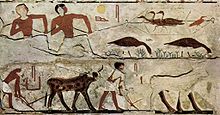Nefermaat
| Nefermaat in hieroglyphics | ||||
|---|---|---|---|---|
Nefermaat (Nefer maat) Nfr m3ˁ.t (with) perfect justice |
||||
Nefermaat was the vizier of the ancient Egyptian king Sneferu ( 4th dynasty ). Maybe he was his son too.
family
Nefermaat was married to a woman named Itet. The couple had fifteen known children, among whom a son named Hemiunu stands out in particular. Under Snofru's successor Cheops he held high offices and was probably responsible for the construction of the Cheops pyramid . The remaining children of Nefermaat are only known from images in his grave. There are three daughters named Djefatsen, Isesu and Pageti and eleven other sons named Isu, Teta, Itisen, Chentimeresch, Inkaef, Serfka, Wehemka, Schepseska, Kachent, Ancherscheretef and Ancherfenedjef.
activity
Nefermaat is best known for his large mastaba in Meidum , in which he was buried with his wife Itet. Nefermaat also carried the title of “head of all royal construction work” and was therefore probably also the builder of the Meidum pyramid .
The two cult rooms of the mastaba have achieved particular fame for the technique of their decoration. Most of the inscriptions and depictions are cut into the stone and then filled in with a colored paste. Nefermaat himself comments on this technique in his grave: "He made his mastaba in this indestructible script".
The "Geese of Meidum"
Part of the Itet cult area has been painted, from here the famous "Geese of Meidum" come. It is a 162 cm long and 24 cm high fragment of painted stucco that is now in the Egyptian Museum in Cairo . It shows six geese arranged in two groups facing away from each other. The two outer animals are bean geese ( Anser fabalis ), the pair on the left shows white-fronted geese ( Anser albifrons ) and the one on the right red-necked geese ( Branta ruficollis ). The special thing about this painting is not only its extremely detailed rendering of the birds, but also its uniqueness in all of ancient Egypt. While portrayals of white-fronted geese can also be found in a few other places, portrayals of bean and red-necked geese are only known from this grave.
However, the assumption has also been made that the "Geese of Meidum" are a fake of the 19th century. According to Francesco Tiradritti, professor of archeology at the University of Enna , the fact that the species of geese depicted were not native to Egypt and that their wintering areas are instead in Spain and Turkey, the dyes unknown in ancient Egypt, the lack of the for The perspective of meaning typical of ancient Egyptian art , the balance of the image composition based on the golden ratio , unknown to the Egyptians , the unusually good state of preservation compared to other frescoes of the tomb, the blue-gray overpainting of the background around the geese, which deviates from the background of the rest of the scene, and the type of Overpainting of later cracks in the painting surface to be assessed. Tiradritti suspects the alleged discoverer Luigi Vassalli to be a forger , because a basket and a vulture, drawn in the same modern, plastic style and state of preservation, are next to each other at another point of the tomb, which have the phonetic values G and A in symbolic form in the Egyptian hieroglyphic writing, which in turn were the initials of Vasalli's second wife Gigliati Angiola.
literature
- Michel Baud : Famille royale et pouvoir sous l'Ancien Empire égyptien. Tome 2 (= Bibliothèque d'Étude. Volume 126/2). Institut Français d'Archéologie Orientale, Cairo 1999, ISBN 2-7247-0250-6 , p. 490 ( PDF; 16.7 MB ).
- Aidan Dodson , Dyan Hilton: The Complete Royal Families of Ancient Egypt . The American University in Cairo Press, London 2004, pp. 52-61, ISBN 977-424-878-3 .
- Yvonne M. Harpur: The Tombs of Nefermaat and Rahotep at Maidum. Oxford Expedition to Egypt, Oxford 2001, pp. 21-47; 55-94, ISBN 978-0-9540835-0-2 (the basic work on the tomb of Nefermaat).
- Patrick F. Houlihan: The Birds of Ancient Egypt. The American University in Cairo Press, Cairo 1988, pp. 57-62, ISBN 977-424-185-1 .
Web links
- Nefermaat on Digital Egypt (English)
Individual evidence
- ↑ Jürgen Osing: On proverb 534 of the pyramid texts. In: Hommages à Jean Leclant. I. Études Pharaoniques. (= Bibliothèque d'étude. 106/1). Cairo. Pp. 282–283 (on this translation).
- ↑ Color photos under 1 and 2 ( Memento of the original dated June 9, 2007 in the Internet Archive ) Info: The archive link was inserted automatically and has not yet been checked. Please check the original and archive link according to the instructions and then remove this notice. .
- ^ PF Houlihan: Birds of Ancient Egypt. Cairo 1988, pp. 58-59.
- ^ PF Houlihan: Birds of Ancient Egypt. Cairo 1988, pp. 60-61.
- ^ Archeology News Network: Ancient Egypt's 'Mona Lisa' declared fake , accessed April 2, 2015.
| personal data | |
|---|---|
| SURNAME | Nefermaat |
| BRIEF DESCRIPTION | Egyptian vizier of Sneferu |
| DATE OF BIRTH | around 27th century BC Chr. |
| DATE OF DEATH | around 27th century BC Chr. |





